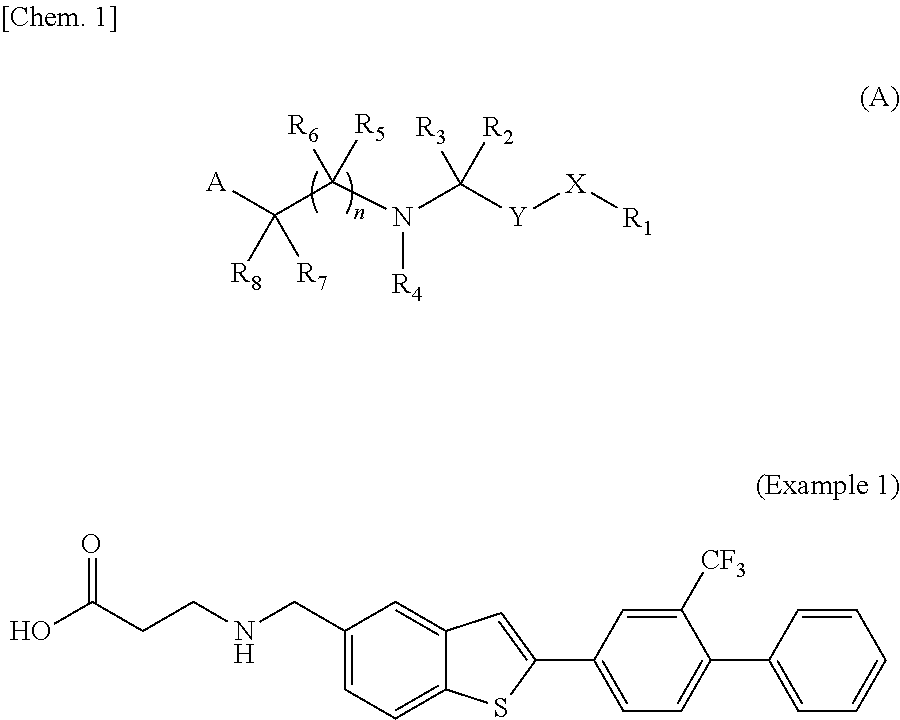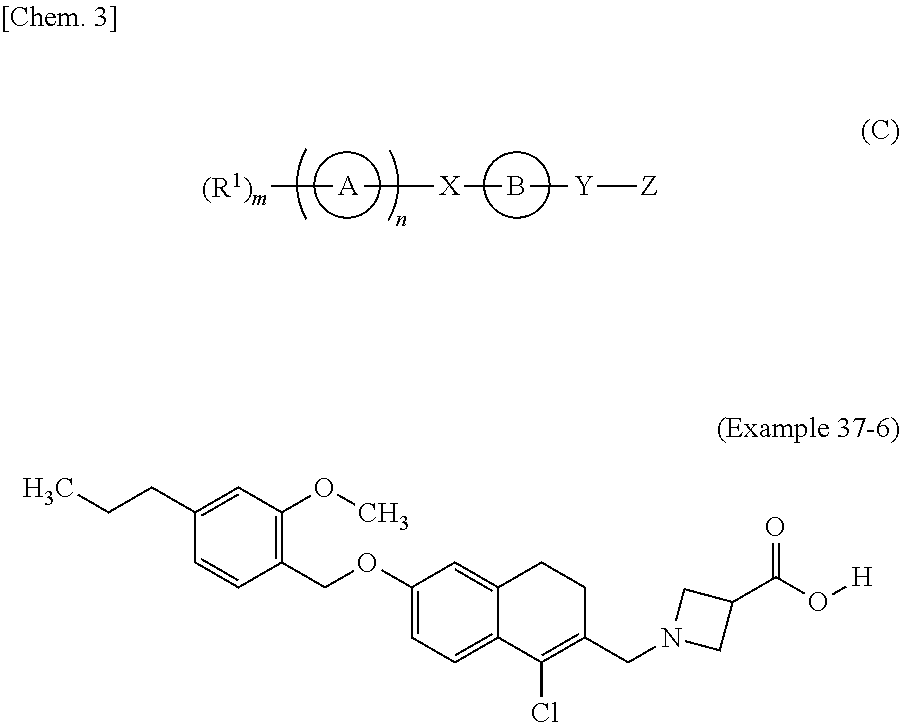2h-chromene compound and derivative thereof
a technology of chromene compound and compound, which is applied in the field of 2hchromene compound and a derivative thereof, can solve the problems of reduced lung function and infrequent pulses
- Summary
- Abstract
- Description
- Claims
- Application Information
AI Technical Summary
Benefits of technology
Problems solved by technology
Method used
Image
Examples
preparation example 1
[0170]7-[(5-Bromo-4-phenyl-2-thienyl)methoxy]-2H-chromene-3-carbaldehyde (120 mg) was dissolved in DMF (2.4 mL). To this reaction liquid were added Zn(CN)2 (65 mL) and Pd(PPh3)4 (65 mg) at room temperature. The reaction mixture was stirred at 100° C. for 5 hours and then poured into 1:1 a mixed vehicle of aqueous NaHCO3 and EtOAc, followed by stirring for 1 hour. The organic layer was washed with brine, dried over MgSO4, and then concentrated under reduced pressure, followed by purification by silica gel column chromatography (hexane:EtOAc=100:0 to 70:30) to obtain 5-{[(3-formyl-2H-chromen-7-yl)oxy]methyl}-3-phenylthiophene-2-carbonitrile (83 mg) as a pale yellow solid.
preparation example 2
[0171]To a solution of methyl 5-bromo-4-phenylthiophene-2-carboxylate in dioxane were added 2-isopropenyl-4,4,5,5-tetramethyl 1,3,2-dioxaborolane and a 2 M aqueous Na2CO3 solution. To the reaction mixture were added palladium acetate and PPh3, followed by stirring at 100° C. for 5 hours. After leaving to be cooled, a saturated aqueous NH4Cl solution was added thereto, followed by extraction with EtOAc. The organic layer was washed with brine, dried over MgSO4, and then concentrated under reduced pressure, followed by purification by silica gel column chromatography (hexane:EtOAc=95:5 to 80:20) to obtain methyl 5-isopropenyl-4-phenylthiophene-2-carboxylate as a colorless liquid.
[0172]In the same manner as in Preparation Example 2, the compounds of Preparation Example 2-1 through Preparation Example 2-4 shown in Tables described later were prepared.
preparation example 3
[0173]To a solution of DMF (2.5 mL) in DCM (3 mL) was added dropwise POCl3 (2 mL) at 0° C., followed by stirring at room temperature for 30 minutes. Subsequently, to the reaction liquid were added dropwise 8-(benzyloxy-3,4-dihydro-1-benzoxepin-5(2H)-one in DCM (4 mL), followed by stirring at room temperature for 1 hour and at 50° C. for 3 hours. To the reaction liquid was added water, followed by extraction with EtOAc twice. The organic layer was combined, washed with water and brine, dried over MgSO4, and then concentrated under reduced pressure. The residue was purified by silica gel column chromatography (automatic purification device; hexane:EtOAc=97:3 to 90:10) to obtain 8-(benzyloxy)-5-chloro-2,3-dihydro-1-benzoxepin-4-carbaldehyde (445 mg).
PUM
 Login to View More
Login to View More Abstract
Description
Claims
Application Information
 Login to View More
Login to View More - R&D
- Intellectual Property
- Life Sciences
- Materials
- Tech Scout
- Unparalleled Data Quality
- Higher Quality Content
- 60% Fewer Hallucinations
Browse by: Latest US Patents, China's latest patents, Technical Efficacy Thesaurus, Application Domain, Technology Topic, Popular Technical Reports.
© 2025 PatSnap. All rights reserved.Legal|Privacy policy|Modern Slavery Act Transparency Statement|Sitemap|About US| Contact US: help@patsnap.com



